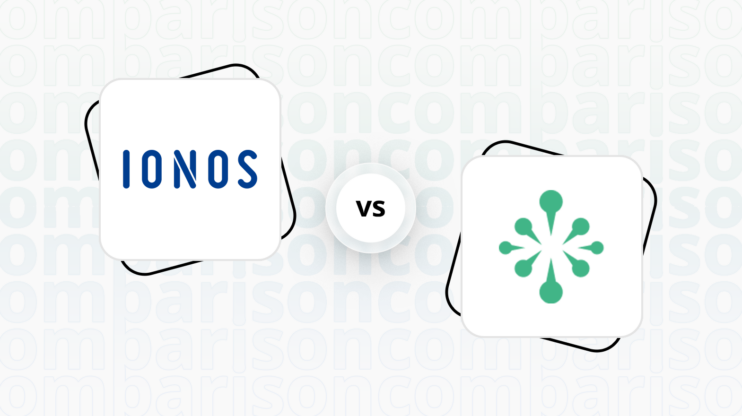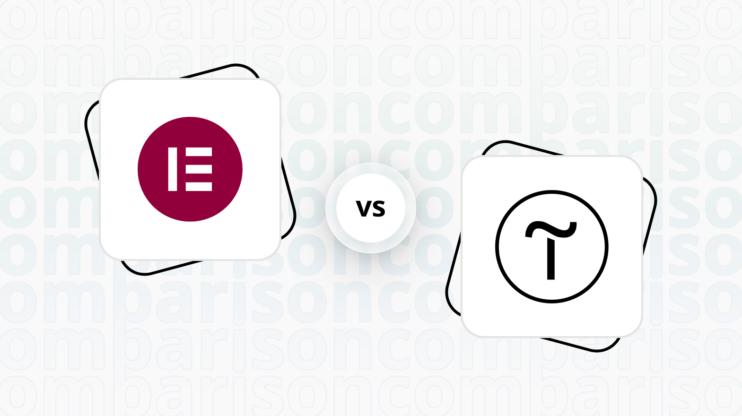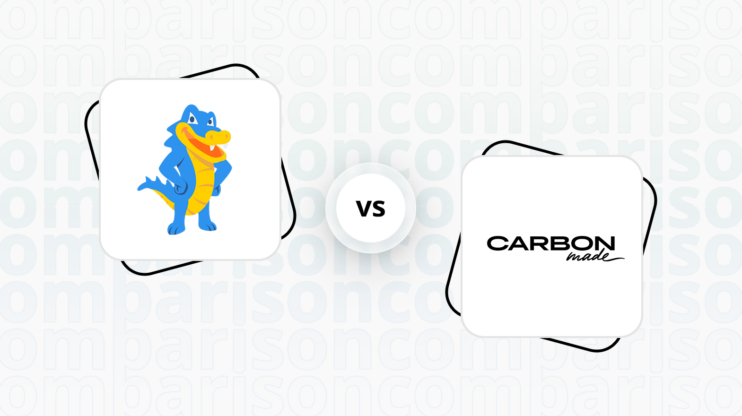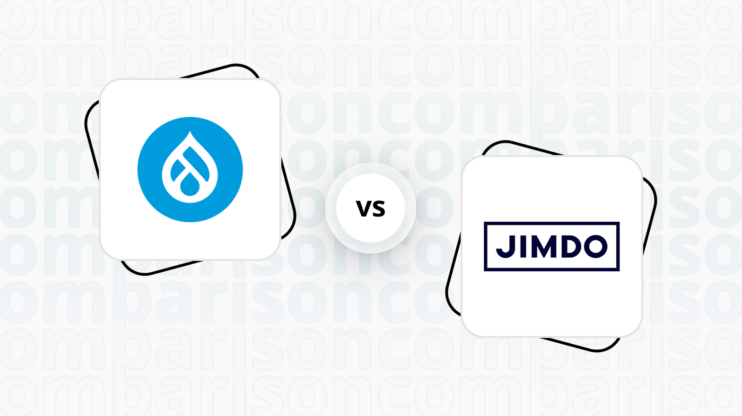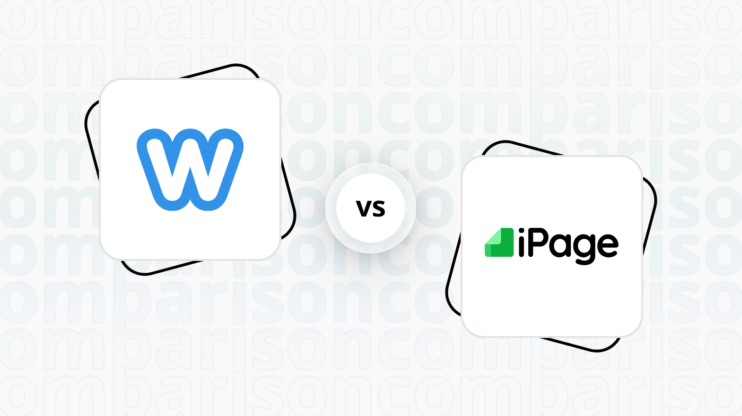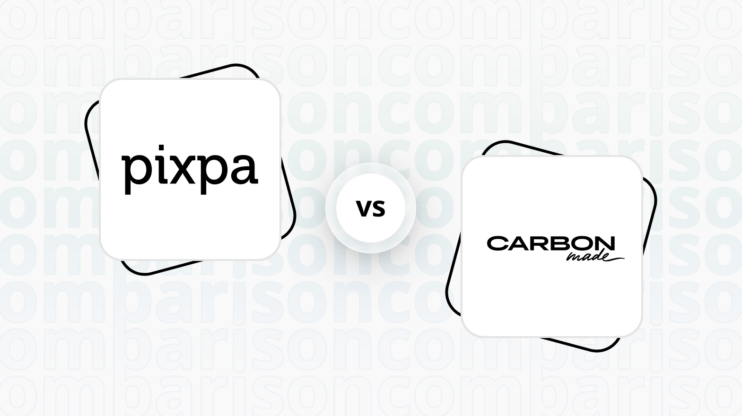Final verdict
Webflow and Framer both offer unique strengths, catering to different user needs and preferences.
-
Webflow (Overall Grade: 7.9/10)
excels in providing a comprehensive solution for professional designers and businesses looking for a robust, scalable platform. With powerful design tools, a flexible CMS, and top-tier hosting services, Webflow is ideal for users who need extensive customization and advanced functionalities. When comparing Webflow vs Framer, Webflow stands out for its superior design capabilities, ecommerce features, and reliable customer support. -
Framer (Overall Grade: 7.1/10)
is a versatile website builder that blends AI-driven design with an intuitive user interface, making it accessible for both novices and experienced designers. Framer offers a wide range of customizable templates and AI tools for content generation, making it a great choice for creative projects and smaller websites. In the Webflow vs Framer comparison, Framer shines with its user-friendly design experience and innovative AI capabilities, though it lacks some of the advanced ecommerce features and support options found in Webflow.

|

|
|
|---|---|---|
|
Design functionalities & templates |
8.6 |
8.5 |
|
Ease of use |
7.5 |
7.1 |
|
Ecommerce |
8.5 |
5.9 |
|
Website Editors |
9.0 |
7.6 |
|
Product testing options |
6.3 |
6.2 |
|
Price |
8.0 |
7.7 |
|
Hosting quality |
8.9 |
7.1 |
|
Website speed optimization |
8.1 |
7.4 |
|
Plugins and integrations |
5.5 |
7.6 |
|
Marketing features |
7.8 |
7.2 |
|
Customer support |
8.3 |
5.6 |
|
Security |
7.8 |
8.2 |
|
AI capabilities |
8.3 |
7.6 |
|
User Management |
8.3 |
7.4 |
Best for ecommerce
 8.5
8.5
 5.9
5.9
Verdict
: Webflow is the superior choice for ecommerce, offering a comprehensive set of features and flexibility, while Framer is more limited and relies on integrations for ecommerce functionality.
-
Webflow
: Webflow excels in ecommerce with its robust platform, offering extensive customization options, seamless payment processing, and a variety of ecommerce templates. It is ideal for businesses looking for a scalable and flexible solution. In the Webflow vs Framer comparison, Webflow stands out for its ability to handle complex ecommerce needs efficiently. -
Framer
: Framer, while innovative in design, falls short in native ecommerce capabilities. It relies on integrations like Ecwid to add ecommerce functionality, making it less suitable for businesses with serious ecommerce requirements. However, Framer’s intuitive design tools and AI-driven features make it a good choice for simpler, design-focused projects.
Best for informational & business websites
 8.6
8.6
 7.5
7.5
Verdict
: When it comes to creating informational business websites, Webflow stands out as the superior choice due to its powerful design tools, flexible CMS, and top-tier hosting services. Framer, while offering a user-friendly interface and AI-driven design features, falls slightly behind in terms of overall capabilities and ease of use.
-
Webflow
: Webflow is a robust platform designed for professional designers, offering a comprehensive solution for creating custom, responsive websites. With a score of 8.6, it excels in providing powerful design tools and flexible CMS options, making it ideal for businesses looking to create highly customized and visually appealing informational websites. Webflow’s top-tier hosting services and extensive template library further enhance its appeal for business websites. -
Framer
: Framer, scoring 7.5, is a website builder that blends AI-driven design with an intuitive user interface. It caters to both novices and experienced designers, offering extensive customization through a comprehensive component library. However, Framer faces limitations such as a learning curve for beginners and a lack of native e-commerce features. While it is a strong contender, it doesn’t quite match the overall capabilities of Webflow for informational business websites.
Detailed comparison
Design functionalities & templates
Design FunctionalitiesRepresents how well each platform allows for creative design and customization of websites.Score Components:
- Template Variety (30%): Range and quality of design templates.
- Customization (30%): Flexibility and options for design alterations.
- User Interface (20%): Ease and intuitiveness of the design process.
- Responsiveness (10%): Adaptability to different devices and screen sizes.
- Innovation (10%): Unique design features and tools.
 8.6
8.6
 8.5
8.5
🏆
Winner: Webflow.
With a score of 8.6, Webflow slightly edges out Framer in terms of design functionalities and templates.
Webflow delivers a robust design experience with a diverse range of template and customization options. Boasting over 1000 pre-built templates covering various industries and website types, including free and premium options, Webflow ensures a constantly evolving library for users. The design customization features include a visual drag-and-drop editor for real-time adjustments, fine-grained control over every aspect of the design, and the ability to inject custom code for advanced users seeking additional personalization and unique functionalities.
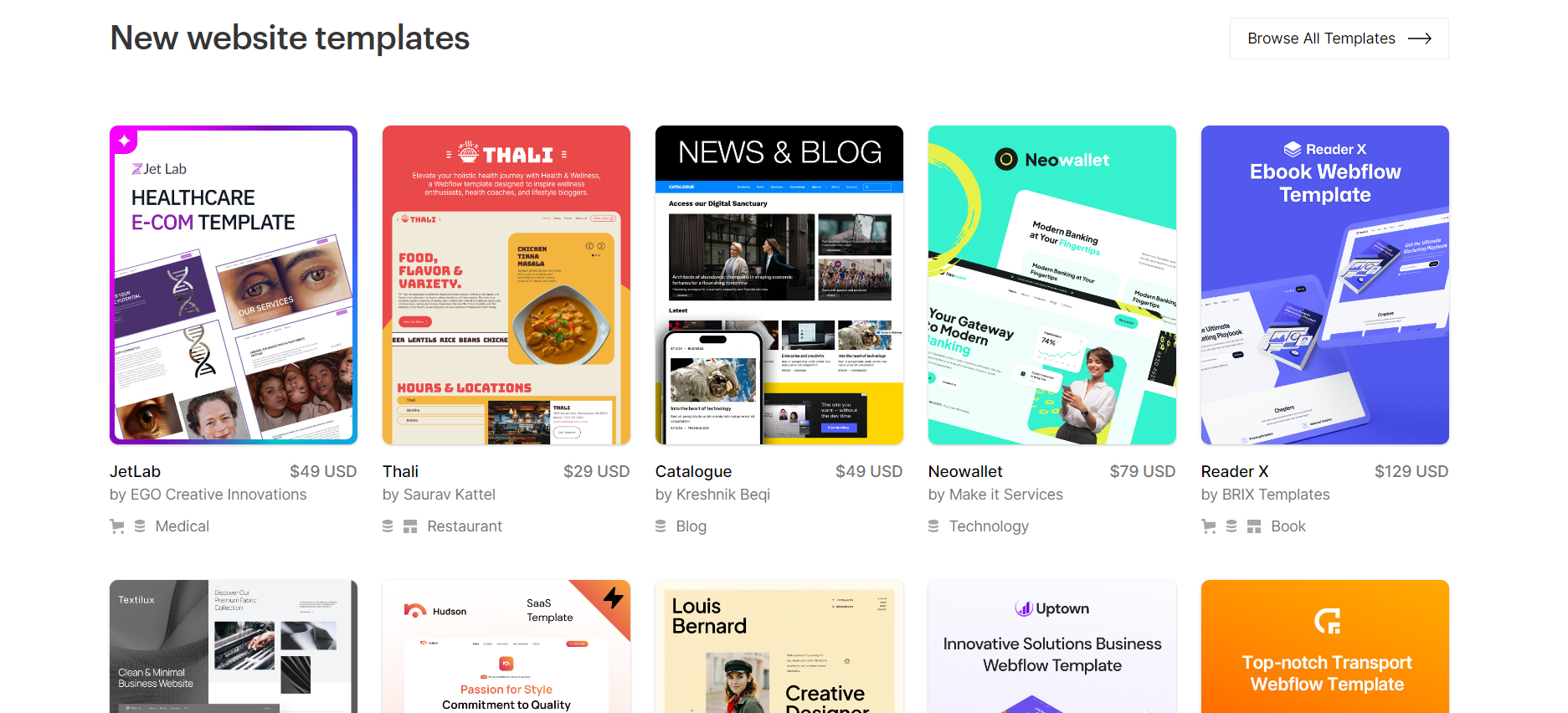
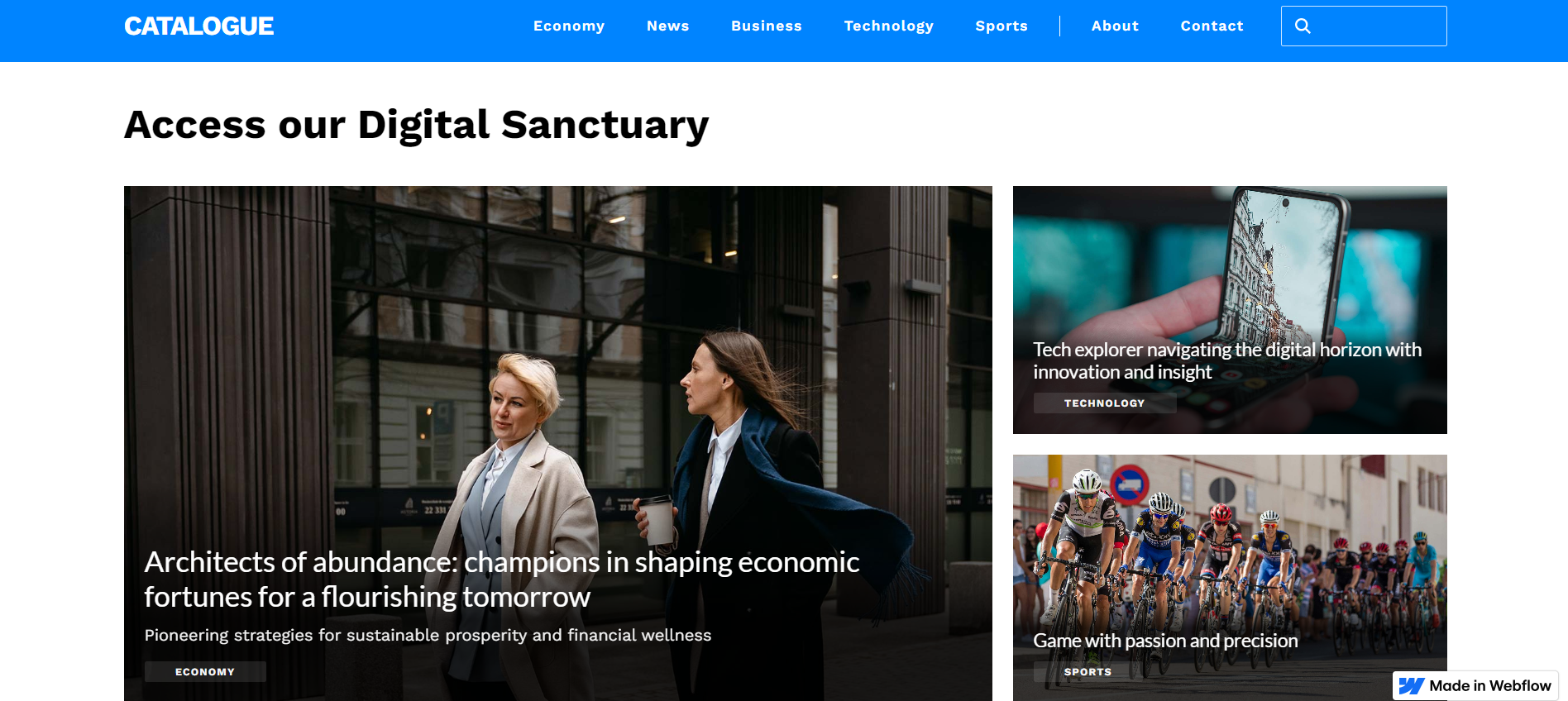
On the other hand, Framer offers a diverse array of over 1,000 customizable website templates and designs, catering to various industries and project requirements. It stands out for its robust design and prototyping features, including responsive design capabilities, real-time collaboration, and extensive import options from other design tools. The platform facilitates a collaborative design process through features like multiplayer functionalities and real components for interactive design, making it an ideal choice for designers, developers, and teams.
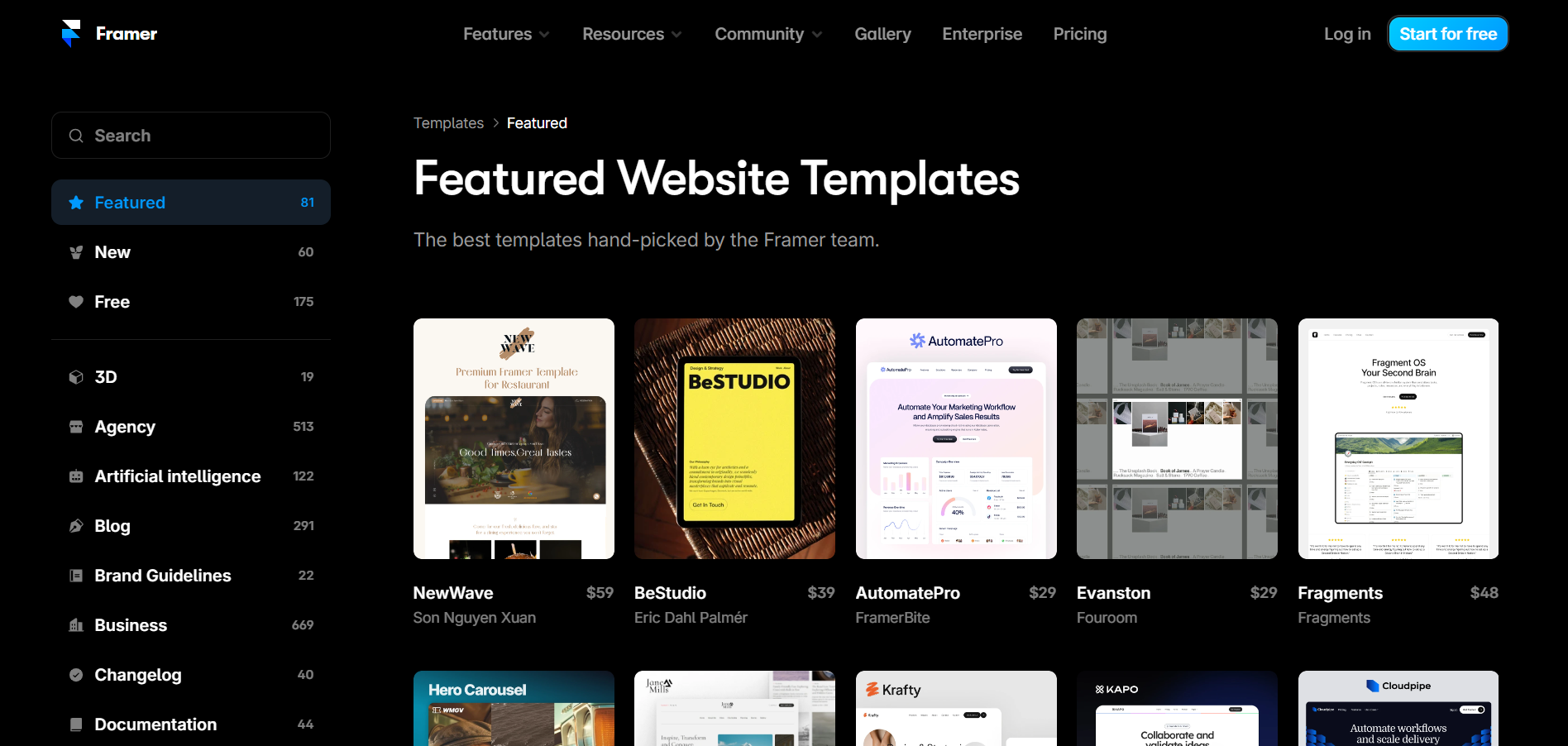
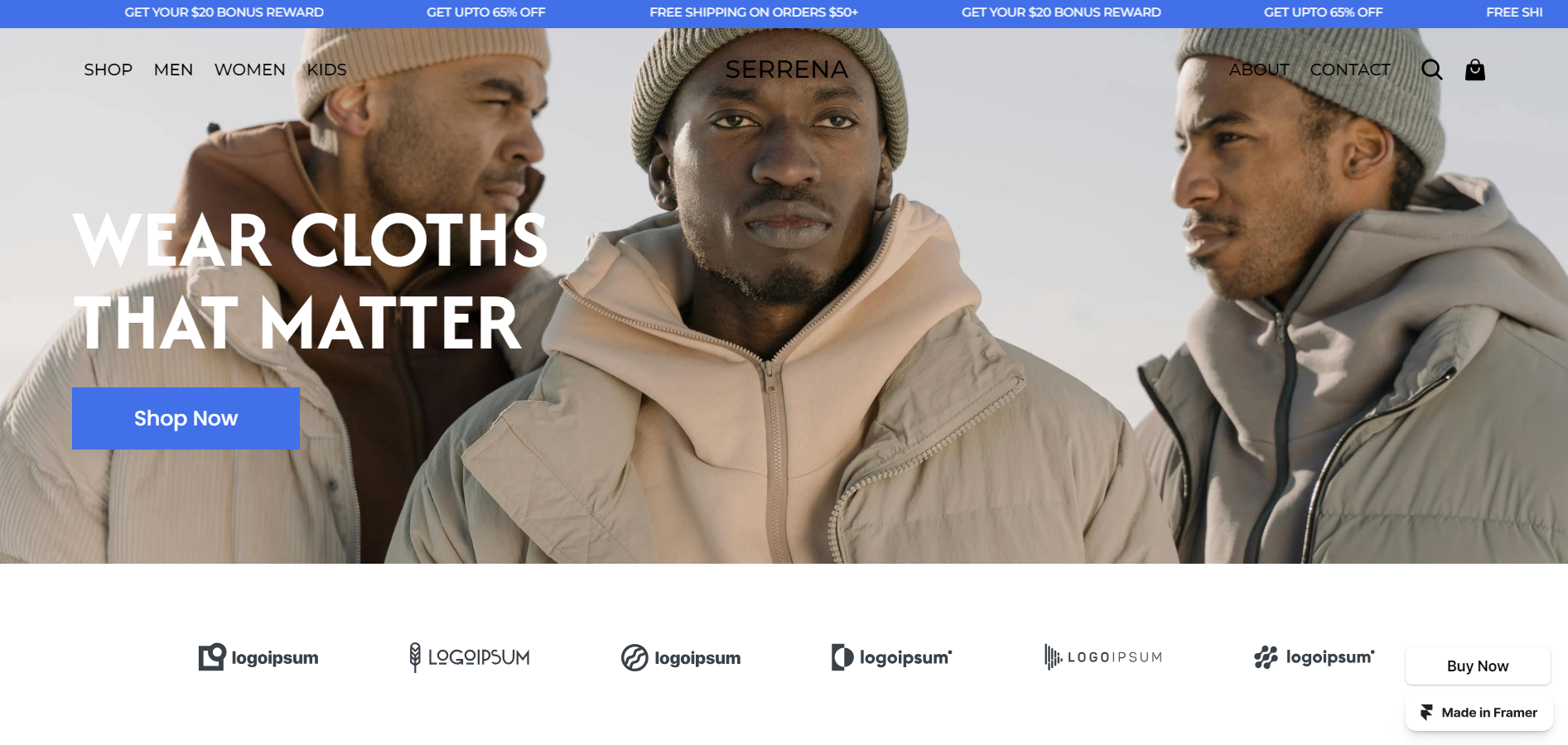
Get a head start on website creation with AI
Create a custom website tailored to your business needs 10X faster with 10Web AI Website Builder!
Ease of use
Ease of useReflects the platform’s overall user-friendliness.Score
Components:
- Learning curve (40%): Quickness and ease of getting started.
- Interface design (30%): Simplicity and intuitiveness of layout.
- User guidance (20%): Quality of tutorials and support.
- Flexibility (10%): Adaptability to various user skills.
 7.5
7.5
 7.1
7.1
🏆 Winner: Webflow
. Scoring 7.5, Webflow edges out Framer, which scored 7.1. While both platforms offer intuitive interfaces and extensive customization options, Webflow’s design flexibility and top-tier hosting services make it slightly more user-friendly, despite a steeper learning curve for beginners.
Learning Resources
🏆 Winner: Tie
. Both Webflow and Framer offer comprehensive learning resources, including detailed courses, tutorials, and active community forums. Whether you’re a beginner or an experienced designer, both platforms provide the tools and resources you need to master their respective interfaces.
For ecommerce
EcommerceMeasures the platform’s effectiveness in supporting online business activities.Score Components:
- Ecommerce themes and templates (20%): Variety and design of templates.
- Product management (25%): Ease of managing and organizing products.
- Payment options (25%): Variety and convenience of payment methods.
- Ecommerce features (20%): Features for managing an ecommerce store.
- Integration (10%): Compatibility with external e-commerce tools and services.
 8.5
8.5
 5.9
5.9
Webflow and Framer offer different ecommerce capabilities. Webflow is a robust platform for creating online stores, offering comprehensive ecommerce features such as easy store creation without coding, extensive customization options, product management with variations, inventory tracking, integration with major payment gateways, automated shipping calculations, tax configuration, and marketing tools like abandoned cart recovery and email marketing. On the other hand, Framer does not offer native ecommerce features directly within its platform. To facilitate ecommerce, Framer can be paired with Ecwid’s free shopping cart extension, which allows for quick and easy addition of online store functionalities to a Framer website.

|

|
|
|---|---|---|
|
Ecommerce themes and templates |
7.5 |
7.0 |
|
Product page customization |
8.3 |
5.5 |
|
Payment processing and commissions |
7.8 |
6.5 |
|
POS capabilities |
6.5 |
3.0 |
|
Payment gateways |
8.0 |
6.0 |
|
Product numbers |
7.0 |
6.0 |
|
Additional ecommerce features |
7.9 |
5.5 |
Webflow ecommerce features:
- Checkout and Payment Processing with Stripe, PayPal, etc.
- Marketing and Promotions
- Tax and Shipping calculations
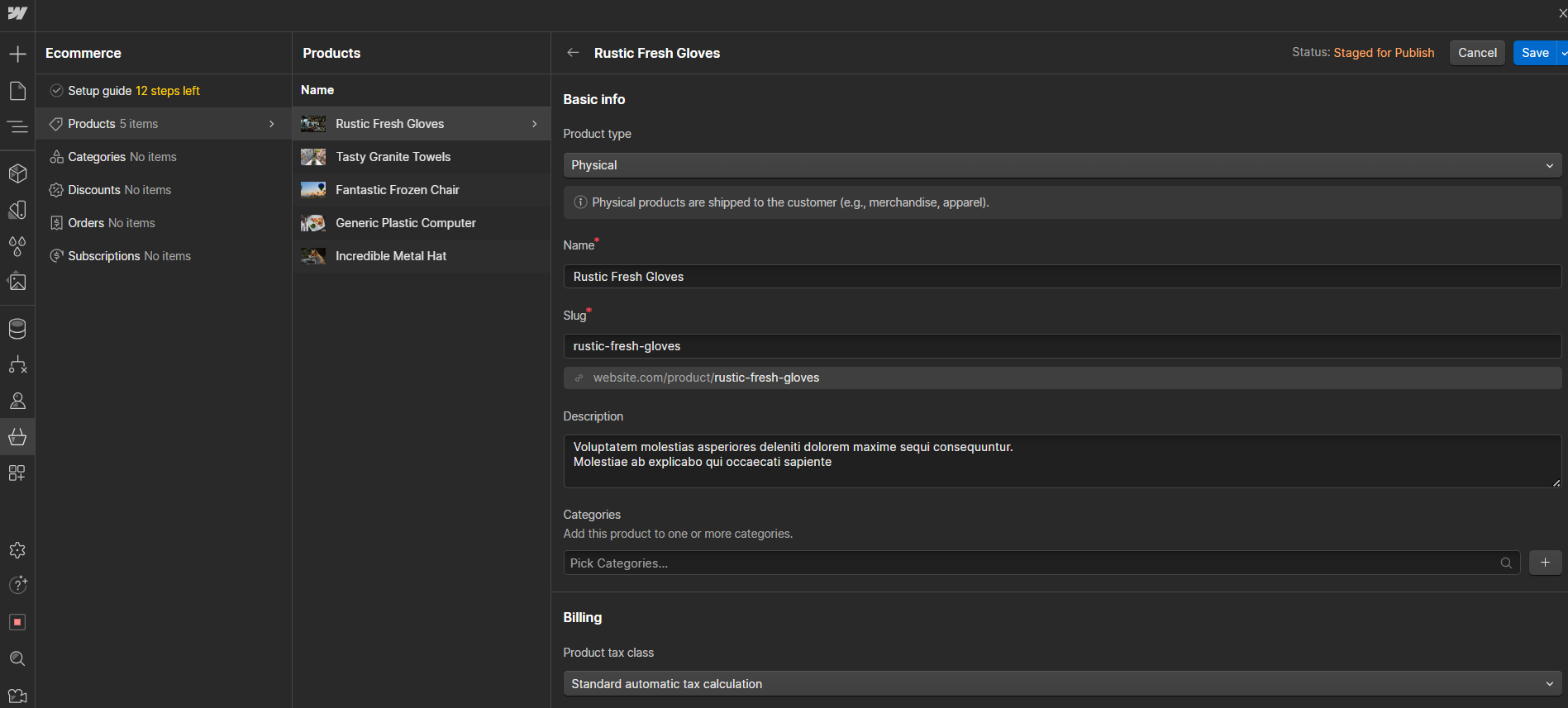
Framer ecommerce features:
- Ecwid integration
Ecommerce themes & templates
Webflow offers a diverse range of ecommerce themes and templates designed to cater to various types of online stores, from fashion and technology to artisan crafts and children’s products. Each template comes equipped with built-in ecommerce functionality, allowing you to easily add products and manage your store without the need for coding. Framer offers 97 website templates specifically designed for eCommerce, providing a wide range of options for various business needs. These templates are highly customizable, allowing for easy adjustments to colors, fonts, layouts, and integration with essential eCommerce tools.
Product page customization
Webflow offers extensive customization options for eCommerce product pages, allowing users to design and personalize their pages without coding. It provides tutorials for creating product pages from scratch, offers responsive templates for various devices, and allows users to add custom code and dynamic content using Webflow’s CMS for maximum customization flexibility. Framer primarily focuses on expanding design possibilities for eCommerce. However, it lacks inherent eCommerce functionalities and instead heavily depends on integrating with platforms such as Shopify and Ecwid. Additionally, while Framer allows for some customization of product pages, these modifications are generally limited to design and layout alterations.
Payment processing
When it comes to payment processing, Webflow provides a flexible and secure platform for payment processing and ecommerce through integrations with leading payment gateways like Stripe and PayPal. This allows users to accept a wide range of payments, including credit card transactions directly from their websites. Framer supports Stripe for payment processing, enabling a wide range of payment options including one-time payments, subscriptions, and more, without requiring coding. While specific transaction fees were not mentioned, such fees typically depend on Stripe’s pricing. Framer’s focus is on online transactions and e-commerce integrations, and there’s no explicit mention of native POS functionality. For the most current details on fees and features, it’s recommended to consult directly with Framer or Stripe.
Website Editors
Website EditorsEvaluates the platforms’ website building and editing capabilities.Score Components:
- Customization tools (40%): Range and power of editing features.
- Editor usability (30%): User experience within the editor.
- Design flexibility (20%): Freedom in layout and design changes.
- Update and maintenance ease (10%): Simplicity of updating and maintaining the site.
 9.0
9.0
 7.6
7.6
🏆
Winner: Webflow
. With a score of 9.0, Webflow’s editor is praised for its intuitive visual interface that simplifies the process of designing and editing responsive websites without requiring deep technical knowledge. It offers a perfect blend of ease of use for beginners and the flexibility for more advanced users, enabling significant cost savings by allowing users to customize and manage their sites without hiring professionals.
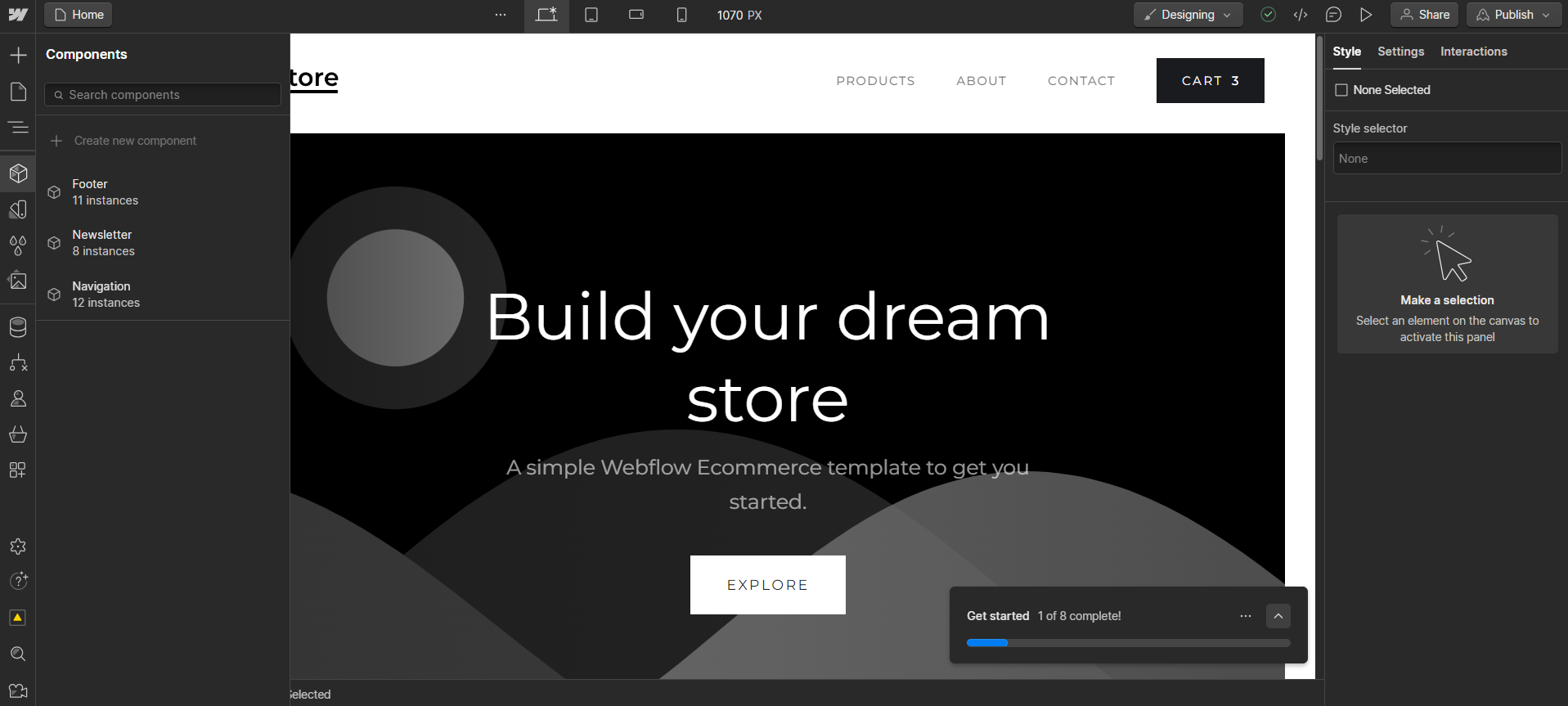
Framer’s website builder editor, scoring 7.6, is designed for high-fidelity prototyping and complex animations, catering to both designers and developers. While it offers a wide range of advanced functionalities, beginners might find it somewhat challenging to navigate and fully utilize without prior experience or a learning curve.
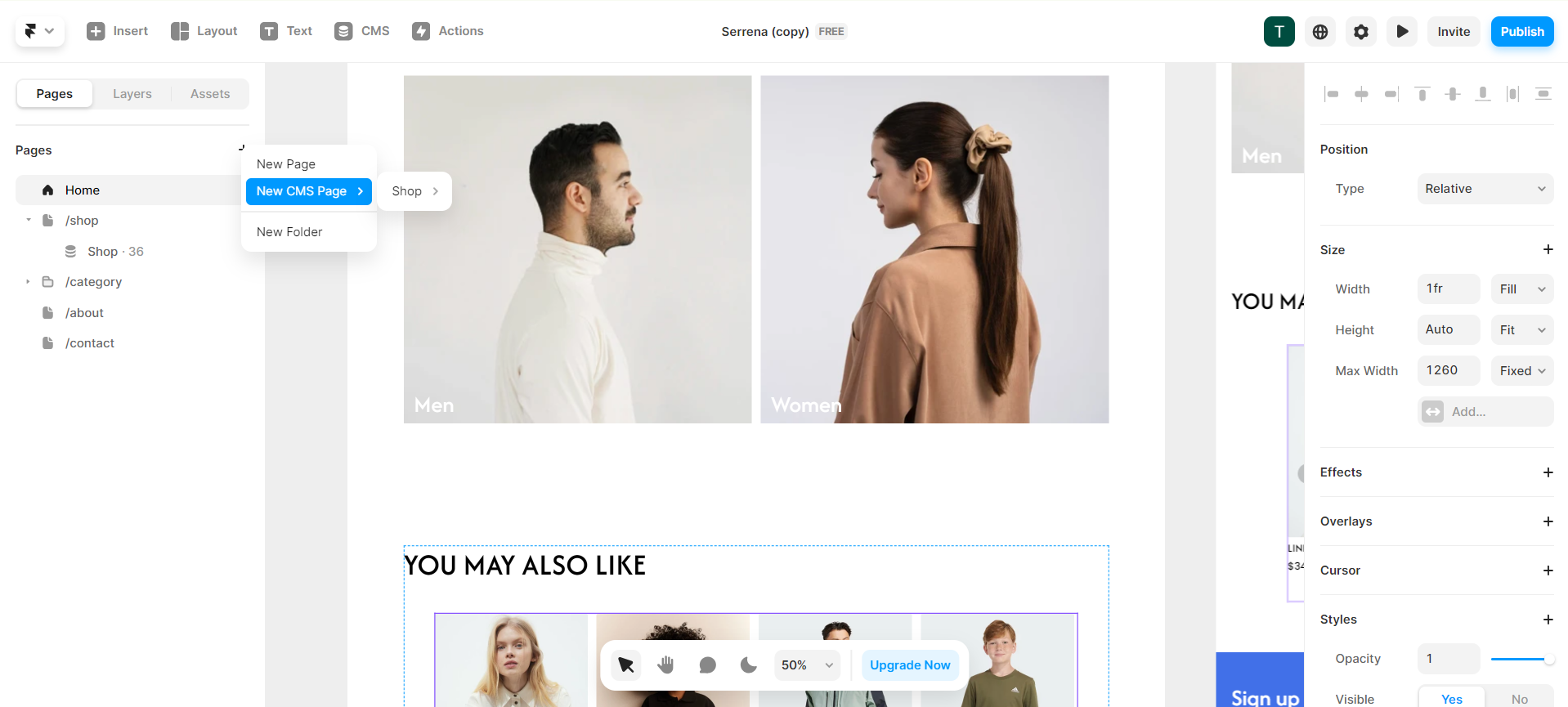
Mobile editor/app
 7.0
7.0
 4.5
4.5
🏆
Winner: Webflow
. Both Webflow and Framer do not have official mobile editor apps. However, Webflow has a third-party app called EditFlow, created by a community member for Webflow users. Currently, the app is only available for iOS. This app allows users to make changes to their websites on the go, which can be a significant advantage for those who need to make quick updates or changes.
Framer, on the other hand, allows users to modify their websites using a mobile browser. However, this comes with certain restrictions and is notably inconvenient. Therefore, Webflow wins this category due to the availability of a third-party mobile app, despite it being unofficial and only available for iOS users.
Product testing options
Product Testing OptionsAssesses the options for trying out platform features before commitment.Score Components:
- Trial quality (40%): Extent and usefulness of the trial or free version.
- Feature accessibility (30%): How many features are available to test.
- Trial duration (20%): Length of the trial period.
- Ease of transition (10%): Smoothness of moving from trial to paid plans.
 6.3
6.3
 6.2
6.2
Overall Result
:
Webflow wins
. Webflow scores slightly higher than Framer with a score of 6.3 against 6.2. Both Webflow and Framer offer a free version, but neither provides a trial version. However, both allow for testing of some features with the free version. Framer offers a money-back guarantee, but only in some regions and within 14 days.

|

|
|
|---|---|---|
|
Free Plan |
Yes | Yes |
|
Trial Duration |
No | No |
|
Testing Premium Features |
Some features with free plan | Some features with free version |
|
Money Back Guarantee |
No | Only in some regions within 14 days |
Price
PriceLooks at the cost-effectiveness and value for money of each platform.Score Components:
- Plan value (40%): What each pricing tier offers.
- Transparency and clarity (30%): Clearness of pricing structures.
- Flexibility of plans (20%): Range of options to suit different budgets.
- Hidden costs (10%): Additional expenses not included in the plan.
 8.0
8.0
 7.7
7.7
Webflow and Framer offer a range of pricing options to cater to different needs, from free or low-cost plans for small projects to custom-priced enterprise solutions for large-scale operations.

|

|
|
|---|---|---|
|
Free |
Starter (Free): Limited features for new sites, including 2 static pages and 50 form submissions lifetime. |
Free (Free/month): Allows 3 websites built on a framer.website subdomain with Framer branding in the footer. Limited to 1,000 traffic visitors and 1,000 CMS items. |
|
$0-$10 |
No offering at this amount. |
Mini ($10/month): Removes Framer branding, allows using a custom domain, includes collaboration with an additional cost for extra editors, custom code embedding, e-commerce support, and limited CMS items. Offers a monthly visitor limit of 2,000 and 1GB bandwidth. Value for price: 6.5 |
|
$15-$25 |
Basic ($18/month): Suitable for simple sites with a custom domain, including basic SEO controls and 500 monthly form submissions. And 100 pages. Value for price: 6.5 |
Basic ($20/month): Offers all Mini features plus increased limits for CMS items (1,000) and traffic (10,000 visitors per month), along with 10GB bandwidth. Value for price: 7.5 |
|
$20-$40 |
CMS ($29/month): For content-driven sites with 2,000 CMS items, 1,000 monthly form submissions, and full API access. And 150 website pages. Value for price: 7.5 |
Pro ($30/month): Enhances Basic plan features with a significant increase in CMS items (10,000), traffic (100,000 visitors per month), and bandwidth (100GB), among other advanced features. Value for price: 8.5 |
|
$40-$45 |
Standard ($42/month): For new businesses with up to 500 ecommerce items, includes basic ecommerce features, and 2% transaction fee Value for price: 8.5 |
No offering at this amount. |
|
$45-$50 |
Business ($49/month): High traffic capacity, advanced features like site search, and up to 10 content editors. Value for price: 8.0 |
No offering at this amount. |
|
$80-$90 |
Plus ($84/month): Higher volume businesses with 0% transaction fees, up to 5,000 ecommerce items, and advanced features. Value for price: 9.0 |
No offering at this amount. |
|
$200+ |
Advanced ($235/month): Scalable solution for large online stores with up to 15,000 ecommerce items and the highest caps and 0% transaction fees. Value for price: 9.5 |
No offering at this amount. |
location. As a result in rare cases the prices displayed here can differ from the ones you see on their
websites.
Hosting quality
Hosting
qualityExamines the reliability and performance of the hosting solutions.Score Components:
- Uptime (40%): Consistency and reliability of website availability.
- Speed (30%): Loading times and performance.
- Bandwidth and storage (20%): Sufficiency of resources provided.
- Data centers (10%): Quality and distribution of hosting infrastructure.
 8.9
8.9
 7.1
7.1
Winner: Webflow
. Webflow offers managed hosting with a 99.99% uptime, and it leverages a globally distributed network of data centers from Amazon Web Services (AWS) and Fastly. Framer, on the other hand, offers cloud hosting with a 99.9% uptime and has 4 data centers globally. While both offer hosting in all their plans, Webflow’s hosting is more robust and reliable, earning it a higher rating.

|

|
|
|---|---|---|
|
Do they offer hosting? |
Yes, included in all paid plans |
Yes, included in all paid plans |
|
Data Centers: |
Webflow doesn’t actually have its own data centers. Instead, it relies on a globally distributed network of data centers from Amazon Web Services (AWS) and Fastly |
4 data centers globally: 2 in US, 1 in Ireland, 1 in Singapore |
|
Type of hosting: |
Managed Hosting |
Cloud Hosting |
|
Uptime: |
99.99% |
99.9% |
|
Uptime Guarantee: |
Only Enterprise plan, 99.99% |
Only for enterprise plan, 99.99% |
Website Speed Optimization
Website Speed OptimizationEvaluates optimization of website loading timesScore Components:
- PageSpeed Score (30%): Google’s score indicating performance optimization.
- Loading Time (30%): The average time until a website is fully interactive.
- Mobile Optimization (15%): Optimization effectiveness for mobile devices.
- Resource Optimization (15%): Optimizing images, scripts, and other heavy resources.
- CDN Usage (10%): Use of CDN to enhance speed across geolocations.
 8.1
8.1
 7.4
7.4
🏆 Winner: Webflow
Both Webflow and Framer prioritize website performance and page speed, but Webflow edges out Framer with a higher Website Speed Optimization score.

|

|
|
|---|---|---|
|
Focus |
Custom Cache Settings, Custom Element Lazy Loading, Automatic Minification, Responsive templates, CDN |
Code Minification, Pre-Rendering, Caching, Image optimization |
|
Performance Tools |
Google Lighthouse, PageSpeed Insights |
Google PageSpeed Insights Integration |
|
Key Strategies |
Custom Cache Settings, Custom Element Lazy Loading, Automatic Minification, Responsive templates, CDN |
Code Minification, Pre-Rendering, Caching, Image optimization |
|
Load Times |
Below 2 seconds average |
Varies depending on optimization and website complexity |
|
Page Speed Scores Range |
77.2/100 |
Varies depending on optimization and website complexity |
|
Core Web Vitals Improvement |
Improving components’ usability, and emphasis on LCP, FID and CLS |
Emphasis on LCP, FID, CLS improvements |
Webflow’s approach to enhancing site speed includes custom cache settings, custom element lazy loading, automatic minification, responsive templates, and a content delivery network (CDN). This approach leverages Webflow’s fast servers and CDN network to boost load speed. Webflow also focuses on improving components’ usability and places emphasis on Largest Contentful Paint (LCP), First Input Delay (FID), and Cumulative Layout Shift (CLS). The average load time for Webflow websites is below 2 seconds, and the average PageSpeed score is 77.2/100.
Framer, on the other hand, focuses on code minification, pre-rendering, caching, and image optimization to enhance website speed. Like Webflow, Framer also places emphasis on LCP, FID, and CLS. However, the load times and PageSpeed scores for Framer websites vary depending on optimization and website complexity.
Get a head start on website creation with AI
Create a custom website tailored to your business needs 10X faster with 10Web AI Website Builder!
Plugins and integrations
Plugins and integrationsMeasures the range and effectiveness of additional plugins and integrations.Score Components:
- Variety of options (40%): Range of available add-ons.
- Integration smoothness (30%): Ease of integrating plugins into the site.
- Quality of plugins (20%): Functionality and reliability of the options.
- Custom integration capabilities (10%): Support for custom or third-party integrations.
 5.5
5.5
 7.6
7.6
🏆 Winner: Framer.
Framer scores 7.6, offering a variety of plugins that cater to different needs such as forms, video & animation, social media integration, audio, and utility functions. These plugins include integrations with platforms like Vimeo, MP4, Lottie, GIPHY, Instagram, Twitter, Google Maps, Trustpilot, Spotify, SoundCloud, Apple Music, and more. Webflow, with a score of 5.5, doesn’t have plugins or extensions in the traditional sense. Instead, it offers a built-in library of website elements and functionalities that you can use to create your website. This library is constantly being expanded, so you’ll always have access to the latest features and tools.
However, Webflow does integrate with a number of third-party services and tools that can add even more functionality to your website. These integrations are not managed by Webflow, so the number of available options and their pricing structures can vary depending on the specific tools you choose.
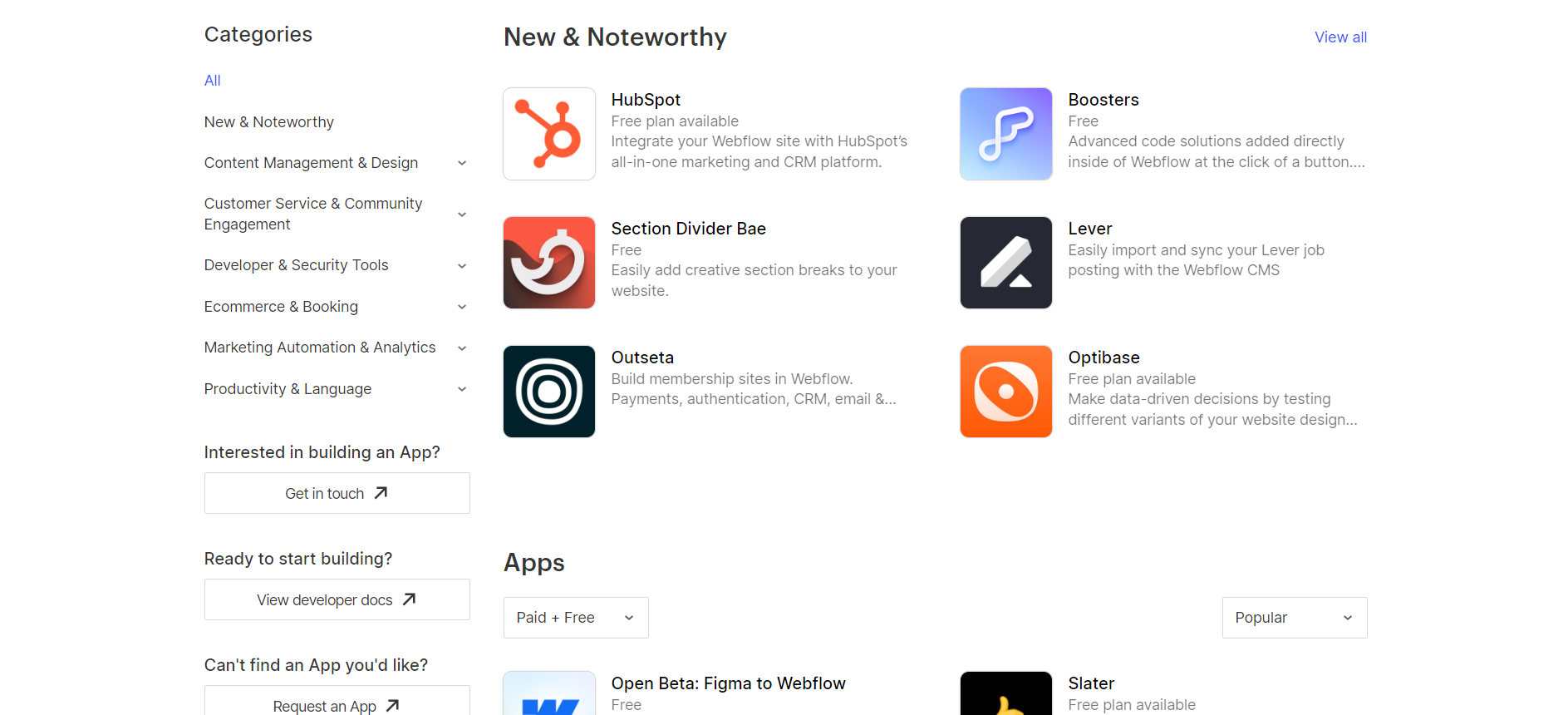
Marketing Features
Design FunctionalitiesRepresents how well each platform allows for creative design and customization of websites.Score Components:
- Template Variety (30%): Range and quality of design templates.
- Customization (30%): Flexibility and options for design alterations.
- User Interface (20%): Ease and intuitiveness of the design process.
- Responsiveness (10%): Adaptability to different devices and screen sizes.
- Innovation (10%): Unique design features and tools.
 7.8
7.8
 7.2
7.2
🏆
Overall Winner: Webflow
. Webflow stands out for its comprehensive set of marketing tools, including ad and promotion management, which Framer lacks. Both platforms offer SEO tools, email marketing, blogging, social media integration, and analytics and reporting.

|

|
|
|---|---|---|
|
SEO Tools |
|
|
|
Email Marketing |
|
|
|
Blogging |
|
|
|
Social Media Integration |
Simplifies content sharing and audience engagement on major social platforms |
Yes |
|
Analytics and Reporting |
Integrates with Google Analytics for comprehensive web traffic and behavior analysis |
Yes, only on higher plans |
|
Ads and Promotions |
Supports ad and promotion management through integration with platforms like Google Optimize |
No |
Customer Support
Customer supportEvaluates the quality and availability of support options.Score Components:
- Response time (40%): Speed of support responses.
- Support quality (30%): Effectiveness and helpfulness of the support.
- Availability (20%): Range of support channels (phone, chat, email).
- Resource richness (10%): Quality of self-help and educational materials.
 8.3
8.3
 5.6
5.6
🏆 Winner: Webflow
. In the Webflow vs Framer comparison, Webflow stands out with its robust customer support system. Webflow offers 24/7 support through live chat, email, and a community forum, ensuring users can get help whenever they need it. Additionally, Webflow provides extensive documentation and video tutorials, making it easier for users to navigate the platform and resolve issues independently.
Framer, on the other hand, primarily relies on self-help options such as a community forum and knowledge base. While users can email Framer’s support team, the lack of detailed information about their availability and working hours can be a drawback. For enterprise customers, Webflow offers a dedicated Customer Success Manager and priority support, whereas Framer’s enterprise support details are less comprehensive.
Security
SecurityLooks at the platforms’ security measures and data protection.Score Components:
- Data protection (40%): Safeguards for user and customer data.
- SSL and encryption (30%): Implementation of secure connections.
- Compliance (20%): Adherence to industry security standards.
- Regular updates (10%): Frequency of security updates and patches.
 7.8
7.8
 8.2
8.2
🏆
Winner: Framer
. Framer takes a comprehensive approach to security, utilizing Amazon Web Services (AWS) for hosting and ensuring data is encrypted at rest. They classify data into categories and manage secrets and encryption keys through AWS Parameter Store and Key Management Service (KMS). Access to secrets and keys is restricted based on the principle of least privilege, and environments are fully separated and isolated for additional security. Framer also emphasizes product security through secure development practices, external security testing, and a bug bounty program.
Webflow, on the other hand, also ensures the privacy and security of user data by implementing robust encryption techniques and strict access controls. They also regularly update their systems and conduct audits to identify and address any potential vulnerabilities. However, Framer’s comprehensive and multi-layered approach to security gives it an edge over Webflow in this comparison.
AI Capabilities
AI capabilitiesMeasures the effectiveness of AI-driven features and tools.Score Components:
- Automation efficiency (40%): Impact of AI on streamlining processes.
- Personalization (30%): AI-driven customization for users or customers.
- AI-Assisted design (20%): Role of AI in website design and functionality.
- Data analysis (10%): Use of AI in interpreting user data and analytics.
 8.3
8.3
 7.6
7.6

|

|
|
|---|---|---|
|
AI Builder |
|
Available |
|
AI Ecommerce features |
|
|
|
AI content generation |
|
Available |
|
Additional AI features |
|
Available |
🏆 Winner: Framer
. Framer, with a score of 7.6, has an AI website builder that simplifies the process of creating and optimizing web content. It also offers AI translation for global audience engagement, text rewrite functionality for content creation, and a headline generator for crafting compelling content. Framer also has additional AI features like AI Style and AI Photo Generating and Editing tools.
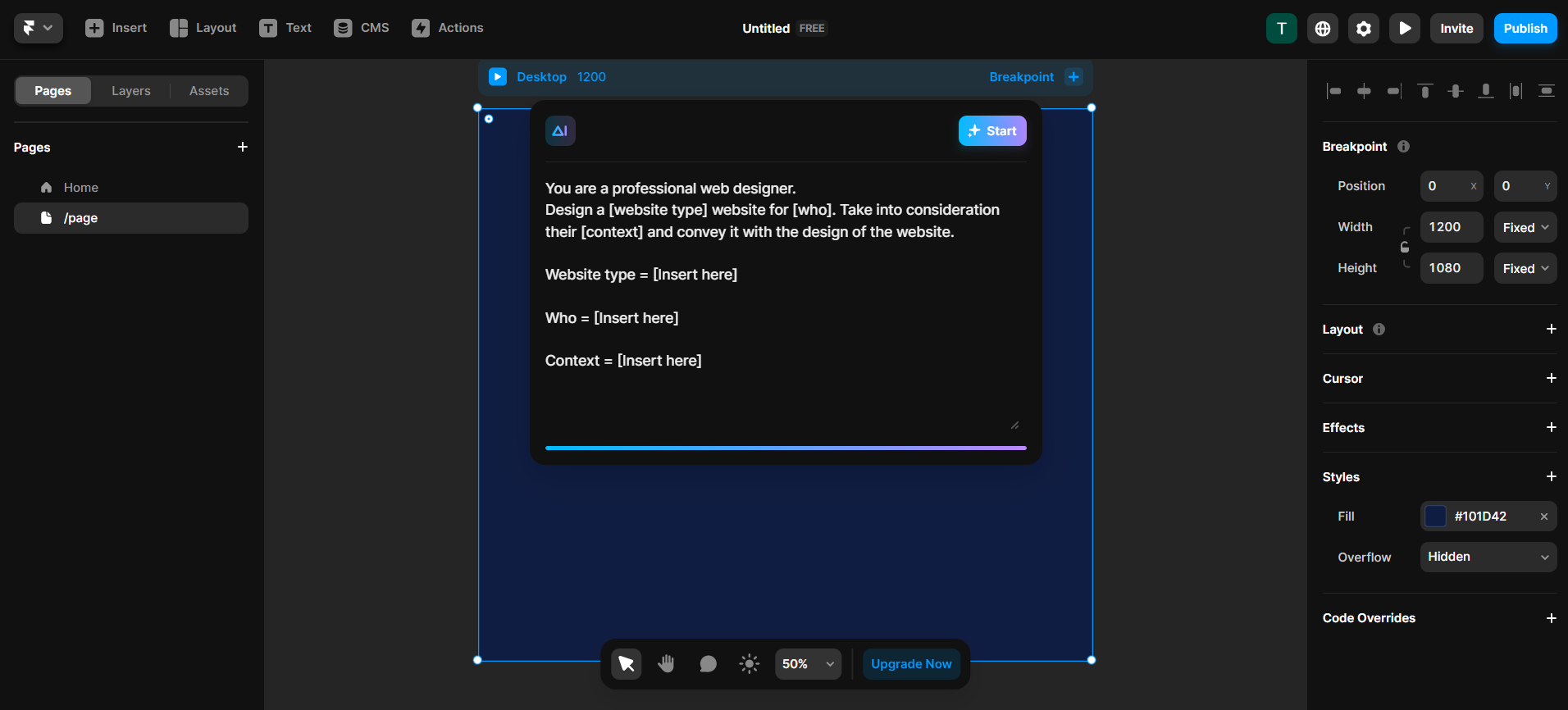
Webflow, with a score of 8.3, does not currently have AI capabilities, but they have announced plans to introduce AI features in the future. These features include smart suggestions for design elements and layouts, and AI-powered content management capabilities. However, as these features are not yet available, Webflow falls behind Framer in terms of AI capabilities.
User Management
User ManagementAssesses the platforms’ capabilities in managing user roles, permissions, and accessibility.Score Components:
- Role Customization (40%): Flexibility in creating and defining user roles and
permissions. - Ease of Management (30%): User interface and tools for managing users.
- Access Control (20%): Effectiveness of access control measures for different user
levels. - Scalability (10%): Ability to manage a growing number of users efficiently.
 8.3
8.3
 7.4
7.4
🏆 Winner: Webflow
. Both Webflow and Framer offer different user roles and access levels, allowing for collaboration and security. However, Webflow offers more granular control with a wider range of user roles.
Webflow User Roles and Access Levels:
| Role | Description | Access Highlights |
|---|---|---|
| Workspace Owner | Full control over Workspace settings and member management. | Edit settings, manage billing, access/edit all sites, invite/remove members, manage permissions. |
| Workspace Admin | Similar to the owner with some restrictions. | Edit settings, manage billing, access/edit all sites, invite/remove members (except owner), manage permissions. |
| Workspace Member | Limited control focused on site interaction. | Download invoices, access/edit sites, invite members. |
| Workspace Guest | Temporary collaborators with limited access. | Access/edit sites. |
| Workspace Commenter | Limited to commenting for feedback on sites. | Create/view/resolve comments, preview sites. |
| Site Admin | Full control at the site level. | Manage permissions, delete/transfer sites, billing management, design and publish changes. |
| Can Design | Design capabilities with some restrictions on publishing. | Design in Designer, create/modify classes and components, publish changes with permission. |
| Can Design (Limited) | Restricted design capabilities for Enterprise customers. | Create new classes, modify created classes, limited publishing capabilities. |
| Can Edit | Content editing without full design privileges. | Edit text/links/images, manage assets, publish Collection items and Ecommerce products. |
| Can Comment (Site Level) | Commenting for feedback at the site level. | Create/view/resolve comments, preview sites. |
Framer User Roles and Access Levels:
| Role | Description | Access Highlights |
|---|---|---|
| Designer | Focuses on the aesthetic and UI/UX aspects of the website. | Can create and modify design elements, utilize animation libraries like Framer Motion, and implement accessibility settings. |
| Content Editor | Manages and curates content for the website, including text, images, and other media. | Can edit CMS content, use localization features for different regions, and modify SEO settings. |
| Developer | Works on more technical aspects, such as custom code and integrations. | Has access to deploy options, can use custom domains, manage project permissions, and apply custom code for further optimization. |
| Project Manager | Oversees the project, coordinating between different roles and ensuring the project meets its deadlines and goals. | Can invite collaborators, assign roles and permissions, and manage versions and rollbacks for efficient site management. |
| Collaborator (General) | A role that can encompass various levels of access based on project needs, including design, content, and deployment tasks. | Access can be customized to include a mix of design, content, and deploy permissions based on the project’s needs and the individual’s role within the team. |
Additional Features

|

|
|
|---|---|---|
|
SSL Certificate |
|
|
|
Custom Domain |
|
|
|
Free Custom Domain Included |
|
|
|
International Domains |
|
|
|
Mobile Responsive |
|
|
|
Page Speed |
|
|
|
Website Builder Mobile App |
|
|
|
Convert a Website To An App |
|
|
|
Website Analytics |
|
|
|
Multilingual Sites |
|
|
|
Multiple Users |
|
|
User Feedback
Webflow receives high praise for its user-friendly interface, eliminating the need for coding while offering extensive design flexibility. Users appreciate its scalability, cost-effectiveness, and seamless integration of essential features like forms and CMS. However, some users note a slight learning curve and occasional limitations, particularly in ecommerce functionalities and content management. Overall, Webflow proves to be a powerful tool for building and managing websites, offering robust features for both beginners and experienced developers, albeit with some room for improvement in certain areas like collaborative editing and content management.
Framer receives high marks for its user-friendly, no-code approach to web and prototype design, offering extensive tutorials, templates, and drag-and-drop functionalities that expedite the design process. Users appreciate its integration with tools like Figma, AI-generated responsive designs, and real-time collaboration features. Critiques focus on a steep learning curve for newcomers and limitations in customer support and features without premium access. Despite these drawbacks, Framer is lauded as a powerful design tool that enhances creativity and efficiency in web development.
The making of this blog
We followed a clear, step-by-step process to write and research this article.
FAQ
Which platform is better for ecommerce, Webflow or Framer?
Can I use Webflow and Framer for building informational and business websites?
How do Webflow and Framer compare in terms of design functionalities and templates?
Which platform is more user-friendly for beginners?
How do the website editors of Webflow and Framer compare?
What are the main differences in pricing between Webflow and Framer?
Which platform offers better hosting quality?
In terms of website speed optimization, which platform performs better?
Which platform has better plugins and integrations?
How do Webflow and Framer compare in terms of customer support?










